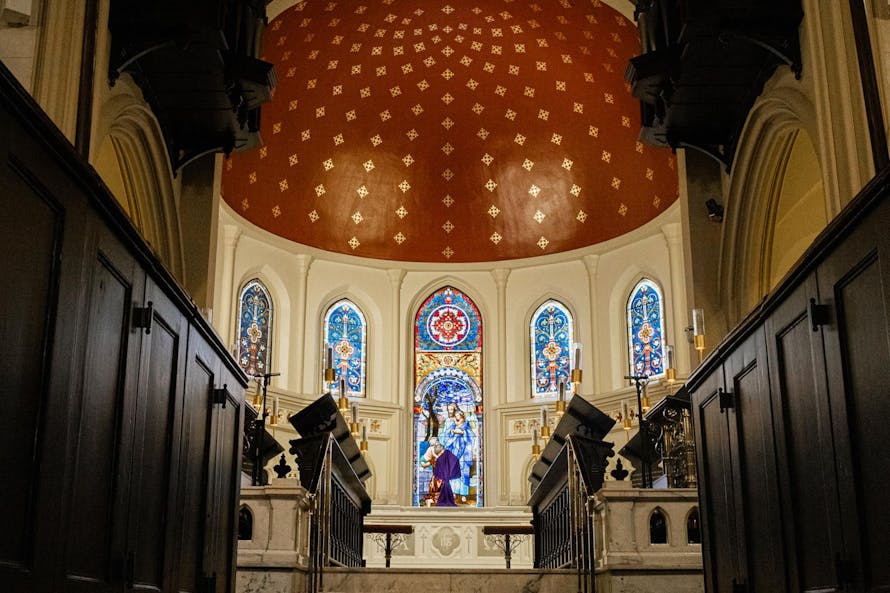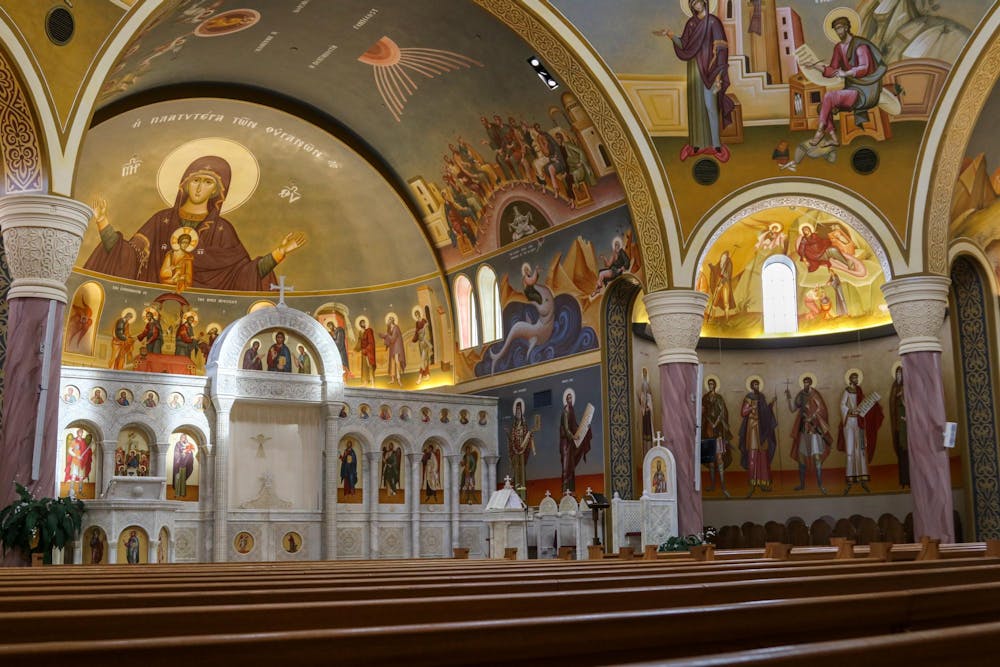Inside Trinity Episcopal Church's cathedral, detailed stained glass and large arches surround the grand building.
While it looks like it was built recently, the cathedral is nearly 50 years old, and the church's history dates much further back, all the way to the 19th century.
Columbia is home to many religious buildings, some dating as far back as the city's beginnings. These historic buildings have stood tall as the city around them has changed and expanded.
Trinity Episcopal Church is the oldest still-standing church in Columbia. Originally built between 1811 and 1812, it is one of the few churches that survived the destruction Columbia faced during the Civil War.
Sitting at the corner of Senate and Sumter streets, it is believed to be the geographic center of Columbia, marked by a metal pipe sticking out of the ground in its graveyard, said Connie Britt, a retired docent.
Britt has been a church member since 1992 and acted as a guide for the church in her position. She was first invited to Trinity by her friend on Christmas Eve and realized Trinity was meant for her, she said.
"It was such a beautiful service, and I just loved it," Britt said. "I've been here ever since."
Britt started getting more involved with Trinity and eventually worked at its bookstore. She used to be a history teacher, and once she retired, she decided to become a docent, where learning history goes hand in hand, she said.
Britt has seen the building grow immensely during the more than 30 years she has been with the church. She said the church started out on the northwest corner of the block and has now expanded to the whole block.
“They say one of the signs of a living organism is that it continues to grow,” Britt said. “And that is certainly true of Trinity.”
The original church was just a little wooden frame building, Britt said. Once more people started attending the church, it expanded in 1840 with the construction of the central part of the cathedral that is there today.
Britt said she witnessed the restoration of the church's stained glass windows, foundation and the creation of several new buildings since she has been a member.
The cathedral is one of the earliest examples of Neo-Gothic architecture in the country, Britt said. The pointed arches, stained glass windows and pointed towers are influenced by European design.
While its grand design impressed Britt, she said the church is meaningful to her because it was there for her at an emotional point in her life.
"It was a new point in my life when I retired from teaching. My mother passed away, and my life was sort of starting over," Britt said. "That's what brought me to where we are right now ... a great deal of my life is now involved with Trinity."
The size of the congregation kept growing, making it necessary to expand the building again in the 1860s, Britt said.
Britt said Trinity’s proximity to the Statehouse and USC, as well as its many different services, led to the growth of the church's congregation because many students and professors attend its services.
When the church closed for the coming expansion, the Civil War began. Union Major Gen. William Tecumseh Sherman invaded Columbia in 1865 with his men and started fires by shooting flaming balls of cotton that destroyed many buildings.
Trinity was not one of them.

The inside of Trinity Episcopal Cathedral's main sanctuary stands on Feb. 22, 2024. The main sanctuary of the church boasts intricate stained glass windows and architectural grandeur, offering parishioners a space for spiritual reflection.
Because of the costs of the expansion, Trinity could not afford a wooden roof like other churches and had to make do with a cheaper tin roof. Britt said divine intervention and the metal roof prevented Sherman’s fire from spreadingto Trinity
"It was the Lord's miracle, because those balls of cotton didn't slide in between the sheets of tin," Britt said. "So we did not burn down."
Holy Trinity Greek Orthodox Cathedral is another church with deep roots in its history.
Established more than 85 years ago, the church grew in size to accommodate the growing number of people attending, said Michael Platanis, the reverend father of Holy Trinity Greek Orthodox Cathedral.
The parish was built In 1936 on the corner of Franklin and Sumter streets, where the community prayed in a small house. The parish then moved to the first edition of the church, which was built in 1948 on the corner of Calhoun and Sumter streets.
The church had surrounding commercial and residential buildings torn down around it to help its expansion, Platanis said.
The construction of the cathedral's largest church building started in 2009,, which Platanis said was necessary for the future of the church. The congregation then conducted a study at the time and realized a larger cathedral was within its reach.
“We simply outgrew (the original building),” Platanis said. “People, at that time, realized that there's a time to (expand), and if you don't do it during that time, you miss that opportunity.”
Platanis said that even though the cathedral is not as old as others in Columbia, the growth of the church is something to be noticed, and the community will continue to build on the traditions of previous generations.
“The people, obviously, who began this church, they were very poor, hard-working people,” Platanis said. “That little humble community became a cathedral, and it welcomes people into the downtown quarter of Columbia, South Carolina.”
Platanis said he admires and respects the church and the generations of worshippers before him because of the traditions of service they established.
"They lived according to the same traditions we live according to, so there's a very beautiful line of history," Platanis said.
Near the heart of Columbia, the First Baptist Church of Columbia is another one of the oldest churches in the city.
The First Baptist Church of Columbia was first organized in 1809. The church then opened up its building in 1811 on Sumter Street.
The original church was replaced with its oldest sanctuary in 1859, said Buster Whitlock, the minister of administration for the church. Thirty years ago, in 1992, a new sanctuary was built to replace the original.
First Baptist Church in 1860 was the site where South Carolina delegates unanimously voted to secede from the country.
Even though the church's property is filled with buildings and has grown considerably since its establishment, Whitlock said First Baptist Church is just as welcoming as any other church because of their services and spiritual encouragement.
“We're a pretty big church that feels like a small church,” Whitlock said. “(It has a) very personal feeling and (is) warm and friendly.”
With Columbia's rich history spanning centuries, these churches have expanded and changed with the city. As the years go on, Britt said they will continue doing so and grow with Columbia.
"We are still growing," Britt said. "The size of the congregation has had peaks and valleys since I've been here, but right now it's at a growth spurt."

